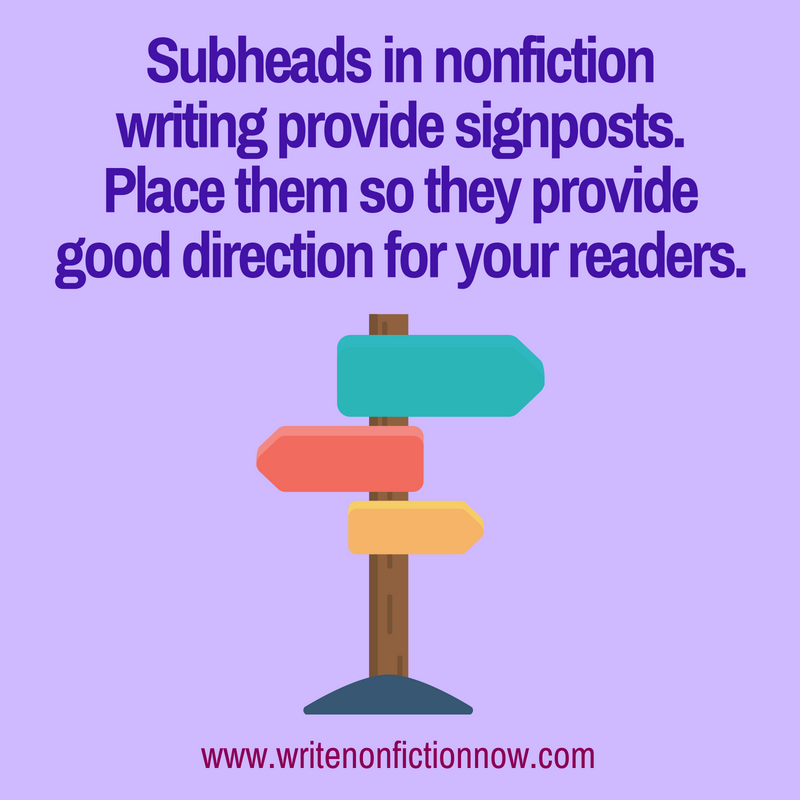Thursday, August 16, 2018

Subheads. They’re an essential element in most nonfiction writing. Today book editor
C.K. Bush (
@theladyck) explains how and why to use them. Apply her tips to make your nonfiction easier to read.
Until I got to my first entry-level publishing job formatting finished manuscripts for the copyeditors, I had no idea what a “subhead” was. Then, the girl training me told me to “format the subheads.” She clicked on a bit of text, hovering above the next paragraph, and I realized then that I had seen subheads in nonfiction writing my whole life. In fact, after she pointed them out to me, I couldn’t
unsee them—subheads were everywhere, holding together any long piece of nonfiction.
Subheads aren’t an element you’re taught in your high school or freshman writing seminars. They don’t fit tidily into a five-paragraph essay. But, used well, they can form a kind of scaffolding that can unobtrusively hold together a longer narrative. Once you understand what subheads are, and how they work, you’ll see that they make your writing both easier to read and to write.
What is a subhead?
Look up one line. See that bit in bold that acts as the title to a new section of this piece? That is a subhead.
In most books, printed articles, and online pieces, subheads are designed to appear differently than the main body text. This may be done using different fonts, colors, type sizes, or just using bold or italic formatting.
Subheads serve as a paragraph heading when the paragraph is starting out a new section within the overall piece. You can have several levels of subheads, just like in an outline; these different levels further differentiate subsections within a given section of the work. The most useful subheads come at the real beginning of an idea and are used sparingly (see more on that later.)
Subheads will
always come before paragraphs; no subheads should pop up in the middle of a paragraph (no matter how creatively you format it).
Subheads make your writing both easier to read and to write.Click To Tweet
Why use subheads?
Subheads have many uses in nonfiction writing. First, they are a quick way to transition between more significant ideas in your overall piece. They allow you to do so without expending a lot of empty words explaining that you’re transitioning to a new idea.
In the business, we call the bits of writing that indicate to a reader where you are going within the logic of the piece “signposting.” Too much narrative signposting can get tedious; no one wants to read several sentences explaining that the writer is going to move on to a new idea before they actually get to the new idea. A subhead, however, can be an effective signpost in and of itself. It can quickly and implicitly announce a shift in ideas without giving too much space to explaining the move so that the reader can stay with you.
Subheads also help you stay on task and organized. Many kinds of nonfiction writing are meant to be expository or explanatory, and subheads act as a tool to keep the overall flow of the piece in order.
In fact, you could transform points in your outline into section subheads to make sure you stick to all the points you want to cover as you write. That’s what I do when I write these guests posts! By keeping the writing focused on covering key points—and structuring the piece transparently around these key points—you’re also making it easier on the reader. They quickly can move through the logic of your writing and pick out the most important ideas, rather than having to sit back and try to puzzle them out.
You should position subheads to demarcate true, clear shifts in ideas.Click To Tweet
The right and wrong of subheads
We’ve gone over the
what,
where, and
why of subheads. Now, let’s discuss the
how. Earlier in this blog post, I talked a little bit about how subheads can be successful. The biggest key to their success lies in the positioning. You should position them to demarcate true, clear shifts in ideas.
Subheads break up the flow of the writing and cause the reader to mentally “clear the deck” to start thinking of a new topic. Therefore, you want to use them when you want to have precisely this effect on readers. If you have a subhead interrupting two paragraphs on the same topic, it will jar the reader and not be useful in terms of guiding them.
Relatedly, subheads succeed when used sparingly. Every paragraph is a new idea, sure, but not every paragraph is a
significant new idea. Can you imagine how annoying this blog post would be if there were a heading before every paragraph? There is such a thing as giving your readers too much direction rather than letting them meander a bit through the writing themselves.
Lastly, it’s important to know that subheads aren’t a catch-all element for every style. Subheads don’t work as well in more creative nonfiction like memoirs, personal essays, or feature reporting, for instance. In those types of pieces, you’re trying to evoke a mood and tell a story more than you’re trying to impart information. So subheads in the traditional sense become intrusive.
Sometimes, most often in journalism, you’ll see essential or especially poignant quotes from the upcoming section serving as section headers. More likely, though, you’ll see a line break that uses a symbol like three asterisks. Or you might see an extra “hard return” or white space to split up sections. This style indicates a shift in the storytelling but doesn’t pull you out of the story at all.
It’s important to know that subheads aren’t a catch-all element for every style. Click To Tweet
Conclusion
Subheads are your friend—get writing, and get sub-heading! Okay, I didn’t really need to make a whole new section just to say that, but when writing a piece about subheads, you end with a subhead!
Do you struggle with subhead use in your nonfiction writing? Tell me why in a comment below.
About the Author
 C.K. Bush
C.K. Bush is a nonfiction editor and writer. She lives in New York City.
Photo copyright: geralt / Pixabay.com
The post
How and Why to Use Subheads in Your Nonfiction Writing appeared first on
Write Nonfiction NOW!.
Nina Amir, the bestselling author of How to Blog a Book and The Author Training Manual, is a speaker, a blogger, and an author, book, blog-to-book, and high-performance coach. Known as the Inspiration to Creation Coach, she helps creative people combine their passion and purpose so they move from idea to inspired action and positively and meaningfully impact the world as writers, bloggers, authorpreneurs, and blogpreneurs. Some of Nina’s clients have sold 300,000+ copies of their books, landed deals with major publishing houses and created thriving businesses around their books. She is the founder of National Nonfiction Writing Month, National Book Blogging Month, and the Nonfiction Writers’ University. As a hybrid author she has published 19 books and had as many as four books on the Amazon Top 100 list at the same time. Her most recent book is called Creative Visualization for Writers, and tomorrow her 19th book will be released, The Write Nonfiction NOW! Guide to Creativity and Flow. Find all her books at booksbyninaamir.com or find out more about her at ninaamir.com.